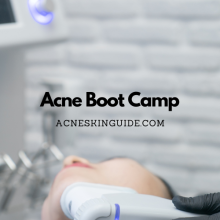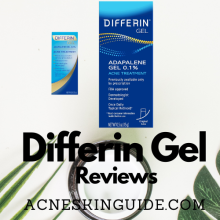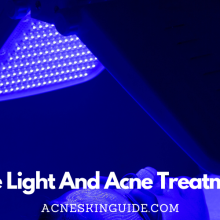Laser Scar Removal Treatments | Acne Skin Guide
Laser scar removal is a revolutionary cosmetic treatment that can diminish the appearance of various scars, from acne scars to surgical marks and burn injuries. Several laser options, including fractional CO2 lasers, Fraxel lasers, and pulsed dye lasers, are designed to target specific scar types and severities. While effective, the procedure is not one-size-fits-all, and success depends on factors like scar type, age, skin tone, and severity.
Multiple sessions may be required, and potential side effects include redness, swelling, infections, and pigmentation changes, particularly in darker skin tones. Alternative treatments, such as topical creams, microneedling, and scar revision surgery, should also be explored. Beyond physical improvements, laser scar removal can profoundly impact self-confidence and well-being. Proper preparation, post-treatment care, and realistic expectations are crucial for optimal results. Working with qualified professionals and prioritizing overall well-being is essential for a successful journey towards renewed confidence.
#1 Recommended Acne Treatment | #2 Recommended Acne Treatment |
 |  |

Unveiling a Renewed Appearance: The Science Behind Laser Scar Removal
In a world where physical appearance holds significant weight, the presence of scars can often be a source of self-consciousness and insecurity. From acne scars to surgical marks, burn injuries to traumatic wounds, these lasting reminders can be challenging to conceal and accept. Fortunately, advancements in cosmetic dermatology have paved the way for laser scar removal, a revolutionary treatment that promises to diminish the appearance of scars and restore a smoother, more even complexion.
Laser Options for Scar Removal
At the forefront of this technology lie several laser options, each meticulously designed to target specific scar types and severities. Fractional CO2 lasers, for instance, employ concentrated beams of light to penetrate deep into the skin’s layers, stimulating collagen production and promoting the formation of new, healthier skin cells. Fraxel lasers, on the other hand, utilize non-ablative technology to gently resurface the skin, gradually improving the texture and appearance of scars over multiple sessions. For those seeking a more targeted approach, pulsed dye lasers offer a specialized solution for vascular scars, such as hypertrophic or keloid formations.
Realistic Expectations and Multiple Sessions
While laser scar removal is widely recognized for its efficacy, it is essential to acknowledge that the procedure is not a one-size-fits-all solution. The success of the treatment is heavily dependent on various factors, including the type and age of the scar, the individual’s skin type, and the severity of the scarring. In some cases, multiple sessions may be required to achieve the desired outcome, as the body’s natural healing processes can take time to fully reveal the transformative effects.
Potential Risks and Side Effects
It is important to note that laser scar removal, while generally safe and effective, is not without its potential downsides. Common side effects may include temporary redness, swelling, and discomfort, which typically subside within a few days. More severe risks, though rare, can include infections, scarring, and pigmentation changes, particularly in individuals with darker skin tones. It is crucial to discuss these potential risks thoroughly with a qualified and experienced dermatologist or plastic surgeon before proceeding with the treatment.
Exploring Alternatives and Complementary Treatments
Recognizing that laser scar removal may not be the ideal solution for everyone, it is essential to explore alternative and complementary treatments. Topical creams and gels containing ingredients like silicone or onion extract can help improve the appearance of scars, while microneedling and steroid injections may be beneficial for specific scar types. In cases of severe scarring, scar revision surgery may be a more appropriate option, allowing for the surgical removal or reshaping of the affected area.
The Psychological Impact of Scarring
Beyond the technical aspects of laser scar removal, it is vital to consider the psychological and emotional impact of scarring. Patient reviews and testimonials often highlight the transformative effects of the treatment, not only on physical appearance but also on self-confidence and overall well-being. By addressing concerns regarding pain, downtime, and satisfaction with results, these firsthand accounts can provide invaluable insights for those considering this cosmetic procedure.
Preparation for Optimal Results
As with any medical treatment, proper preparation is key to achieving optimal outcomes. Timing the procedure appropriately, adhering to pre-treatment skincare routines, and avoiding certain medications or supplements can help ensure that the skin is in optimal condition for the laser treatment. Additionally, maintaining a diligent post-treatment regimen, including sun protection, specialized skincare routines, and a healthy lifestyle, can play a crucial role in preserving the achieved results over time.
The Path to Renewed Confidence
In conclusion, laser scar removal stands as a remarkable testament to the advancements in cosmetic dermatology, offering individuals the opportunity to unveil a renewed appearance and embrace a newfound confidence. However, it is essential to approach this treatment with a comprehensive understanding of the process, potential risks, and realistic expectations. By working closely with qualified professionals, exploring alternative options, and prioritizing overall well-being, individuals can make informed decisions and embark on a journey towards a more self-assured and empowered state of being.
#1 Recommended Acne Treatment | #2 Recommended Acne Treatment |
 |  |
Summary and FAQs
How long does laser scar removal treatment typically take?
The duration of a laser scar removal treatment session can vary depending on several factors, such as the size of the treatment area, the type of laser used, and the severity of the scarring. However, most sessions typically last between 30 minutes to an hour.
For smaller scars or localized treatment areas, the session may be shorter, lasting around 15 to 30 minutes. On the other hand, if multiple or larger areas need to be treated, the session can extend up to an hour or more.
It’s important to note that for many individuals, achieving optimal results with laser scar removal often requires multiple treatment sessions spaced several weeks or months apart. This allows the skin to heal and regenerate between sessions, gradually improving the appearance of the scar over time.
The number of sessions required can range from 3 to 6 or more, depending on the individual’s specific case and the desired level of improvement. Your dermatologist or cosmetic surgeon will be able to provide a more accurate estimate of the treatment duration and number of sessions needed based on an evaluation of your scarring.
Can laser scar removal be performed on all skin tones?
Laser scar removal can be performed on most skin tones, but there are some important considerations based on the individual’s skin color and ethnicity:
Lighter Skin Tones: Laser treatments are generally considered safe for those with lighter, fairerskin tones. The risk of pigmentation issues or burns is relatively low.
Darker Skin Tones: For individuals with darker skin tones, including those of African, Asian, Hispanic, or Middle Eastern descent, laser treatments require more caution. Certain types of lasers, particularly ablative lasers like CO2 and erbium lasers, can potentially cause pigmentation problems or scarring in darker skin tones.
In these cases, non-ablative fractional lasers (e.g., Fraxel, Picosure) are often recommended as they are associated with a lower risk of pigmentation changes or scarring. However, they may also require more treatment sessions for optimal results.
Experienced providers will carefully select the appropriate laser type, settings, and treatment protocols based on the patient’s specific skin tone and ethnicity to minimize risks.
In general, laser scar removal is safest for individuals with lighter to olive skin tones. However, with proper precautions and the right laser modality, it can be performed on darker skin tones as well, but may require a more cautious approach.
It is essential to consult with a qualified and experienced cosmetic dermatologist or laser specialist who has extensive experience treating diverse skin tones to ensure the safest and most effective treatment plan.
What is the recommended interval between laser scar removal sessions?
The recommended interval between laser scar removal sessions typically ranges from 4 to 8 weeks, with most dermatologists suggesting waiting around 6 weeks before getting the next treatment.
There are a few reasons for this interval:
- Healing time: After a laser treatment, the skin needs time to heal and recover. Allowing 4-8 weeks gives the skin a chance to complete the healing process and for any redness, swelling or crusting to fully subside.
- Collagen remodeling: One of the key benefits of laser treatments is stimulating new collagen production to improve the appearance of scars. However, this collagen remodeling process takes several weeks to occur under the skin’s surface.
- Results evaluation: Spacing out treatments allows you and your provider to properly evaluate the results from the previous session before proceeding with the next one. This helps determine if further sessions are needed or if the desired outcome has been achieved.
In some cases, the interval may be adjusted:
- For deeper or more severe scarring, a longer interval of 8-12 weeks between treatments may be recommended to allow maximal collagen remodeling.
- For milder scarring, treatments may be spaced slightly closer together, around 4-6 weeks apart.
It’s important to follow your provider’s specific recommendations, as rushing treatments too quickly can potentially lead to complications or suboptimal results. Allowing the appropriate healing interval optimizes safety and gives the laser effects adequate time to fully develop between sessions.
Are there any specific pre-treatment or post-treatment skincare products recommended for optimal results?
Yes, there are certain pre-treatment and post-treatment skincare products that are often recommended to optimize results and promote proper healing after laser scar removal treatments:
Pre-Treatment Recommendations:
1) Retinoid creams or serums: These vitamin A derivatives help prepare the skin by increasing cell turnover and enhancing the skin’s ability to respond to the laser treatment.
2) Bleaching agents: Products containing hydroquinone or kojic acid may be advised to reduce hyperpigmentation before treatment if the scar is discolored.
3) Gentle cleansers: Using a mild, non-irritating cleanser helps ensure the skin is clean without stripping it before the laser procedure.
Post-Treatment Recommendations:
1) Wound healing ointments: Petrolatum-based ointments like Aquaphor help protect and hydrate the treated area as it heals.
2) Sun protection: Using a broad-spectrum sunscreen (SPF 30+) is crucial to prevent further pigmentation issues and protect the new skin.
3) Gentle cleansers and moisturizers: Fragrance-free, non-irritating cleansers and moisturizers help soothe the skin and reduce inflammation during recovery.
4) Silicone gels or sheets: These products may be recommended once initial healing is complete to help flatten and soften raised scars.
Your provider may also suggest using antioxidant serums, growth factors, or other medical-grade skincare lines specifically formulated to enhance laser treatment results and promote faster skin regeneration.
It’s important to follow their exact recommendations, as improper skincare can potentially disrupt the healing process or lead to adverse effects. Consistent use of the recommended products helps maximize the benefits of laser scar removal.
Can laser scar removal be combined with other cosmetic procedures?
Yes, laser scar removal can often be combined with other cosmetic procedures to achieve more comprehensive results and address multiple concerns simultaneously. However, it’s important to consult with a qualified provider to ensure the procedures are compatible and can be safely combined.
Here are some common cosmetic procedures that can potentially be combined with laser scar removal:
- Chemical Peels: Certain types of chemical peels, such as superficial peels, can be performed along with laser treatments to improve overall skin texture and tone in addition to reducing the appearance of scars.
- Microneedling: This procedure, which involves creating controlled micro-injuries in the skin to stimulate collagen production, can be combined with laser treatments to enhance the overall skin rejuvenation process.
- Dermal Fillers: In some cases, dermal fillers like hyaluronic acid can be used in conjunction with laser treatments to help fill in and smooth out depressed or atrophic scars.
- Botox: While not directly related to scar treatment, Botox injections can be combined with laser procedures to address dynamic wrinkles and fine lines in the treated area.
- Surgical Procedures: For more severe or complex scarring cases, laser treatments may be combined with surgical scar revision procedures, such as excision, punch grafting, or Z-plasty, to achieve optimal results.
It’s crucial to work with an experienced cosmetic dermatologist or plastic surgeon who can evaluate your specific concerns and develop a safe, customized treatment plan that combines the appropriate procedures. They will also provide guidance on the ideal timing and sequence for combining treatments to ensure optimal safety and efficacy.
Additionally, it’s important to factor in the potential for increased downtime, recovery time, and cost when combining multiple procedures. Clear communication with your provider about your goals and expectations is essential for a successful outcome.






